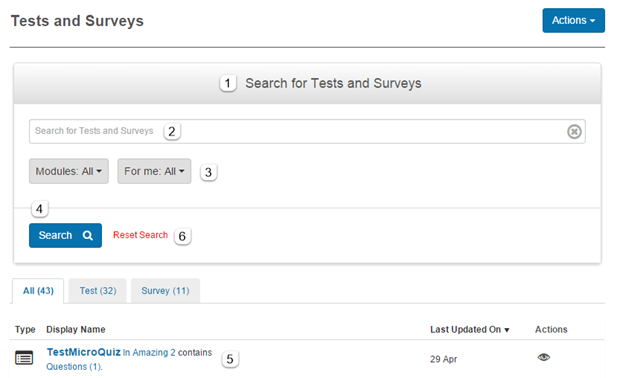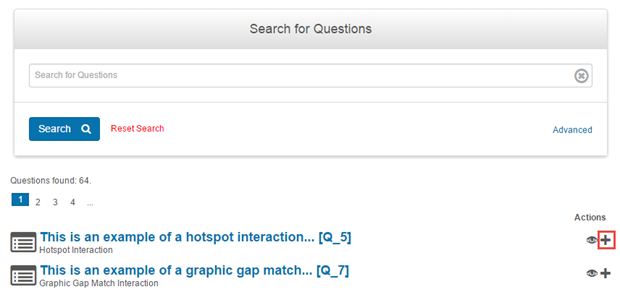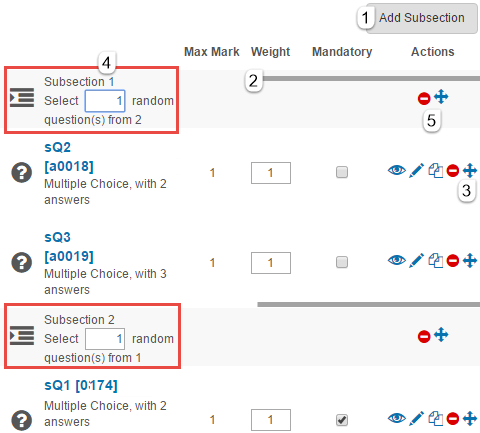Welcome to the Janison Academy help portal
Design
It is important to gauge the learners understanding of the content by providing the ability to test their acquired knowledge. The Janison platform provides a powerful interface that allows organisation to test and analyse results. There are many types of test options within the platform but all follow the same principles > Tests are linked to Questions that belong to the same Module
Tests can belong to:
Tests linked to learning modules support limited question types.
You can read more about this on the topic of Tests and Learning Modules.
Tests linked to assessment modules support all question types.
You can read more about this on the topic of Tests and Assessment Modules.
Note: It is important to decide on how you want to deliver the test to the learner as this will determine what sort of test and module to create.
The search feature allows you to quickly find a Test.
To search for a test select Design > Tests and Surveys.

To inspect a Test’s details navigate to Design > Tests and Surveys and select the desired Test.
Like all detail forms, the Tests and Surveys details form shows linked entities which are also clickable links. For Assessment Tests they might include linked Test Sections, Questions, Stimuli and Resources.
The widget bar at the top allows acces to:
You can view (upwards) all Users that have permissions over the Test, including their role and the scope of this role. Note that while it is possible to configure permissions for a Test here, this can lead to confusion. For example, granting permission to edit a Test, including adding and removing questions, does not allow editing of any Questions that belong to the Test because Questions have a different scope. It may be more appropriate to manage permissions at the Module level, by selecting the Module that the Test and Questions belong to.

A number of windows (collapsed by default) can be found at the bottom of the details form:
If the Test does not contain multiple Sections, this heading will be Questions and the list of Questions linked to the Test can be viewed or edited by clicking to open the window. Randomisation options are located at the top of the window.

Tests can be previewed at any time and you can see how they will appear to candidates in the Test Player. This includes Introductory Test Section sequences but any attempts at answering the Test Questions will not be saved.
To Preview a Test navigate to Design > Tests and Surveys.



To create a Test navigate to Design > Tests and Surveys and select Add Test from the Actions drop-down menu.

Fill out the form details:
Click and select a marking option for the Test from the drop-down list for Marking Mode:
Mixed: any marked Questions will be handled by the system. Manually-marked Question types will be displayed to markers for manual marking.
Automatic: all Questions will be automatically marked. The Test should not contain any manually-marked Question types.
Manual: all Questions will be manually marked.
Do Not Mark: the Test will not be marked.


The Test has now been created, however it does not yet contain any Questions and there are more settings that you can specify.
From this point you can:
On the Test details page there are three ways to add Questions to the Test:



To complete the process, scroll down and click Save.
Note that if you are adding Questions to a Section of a Test, you need to inspect the Section details and locate the Questions window on the Section screen.
Once a Test has been saved, the Edit Test button is available from the Actions drop-down menu in the Test Details form.
Navigate to Design > Tests and Surveys and click the name of the Test that you want to edit. This takes you to its details screen.

By default the Questions in a Test are organised into a single section and the term is not displayed. However, when you create a Test you can choose to have it divided into multiple Sections. Each Section contains one or more Questions. A Multi-Section Test if: the Test is rather long; covers a number of different topics; randomisation options need to be restricted to groups of Questions within the Test; or introduction and exit sequences are required for the Test.
Single and a Multi-Section Tests appear differently in the Test details screen:
When a Test is created you can choose to have it divided into multiple Test Sections, with each Section containing a number of Questions. These Test Sections can also play different roles in the Test Player. For example, you can start the Test with an introductory Test Section, follow this with Test Sections containing Questions and then present different Test Sections to the candidate when they exit the Test depending on whether they passed or failed.
If you selected Use Multiple Sections when you created a Test, you will see the heading Sections, rather than Questions, in the Question’s details screen.
To view and/or edit a Test Section go to the details screen for the Test, see details screen.

Sections contain the following information:
Exit if failed – candidates will see this after they have exited and failed the Test.
Exit if passed – candidates will see this after they have exited and passed the Test.
Introduction – candidates will see this at the very beginning of the Test. You could use it to add a Comment Question Type containing instructions for the candidates.
Question – candidates answer Assessment Questions in this Test Section.
Survey – candidates answer Survey Questions in this Test Section.
Note that the Type cannot be changed once the Section has been created. If you do need to change it, delete the Section, then create it and re-link the Questions. Note also that deleting a Section does not delete its linked Questions.

Note that you should select Hide from Dashboard for Test Sections of type Introduction (see point 2 above).

To add a new Section to a multi-Section Test, go to the Test’s details page and click to open the Sections collapsible window.

An important component of CLS Tests is the ability to configure pass/fail rules and the number of times that a learner can attempt a Test. You will see this window if you checked Set pass/fail outcome on the Test Edit Form.
Navigate to Design > Tests and Surveys.

The following fields are available:
Click Save to save any changes that you have made.
Be very careful changing these settings for Tests that are currently in use. If workflows are enabled, the workflow state will ensure that this information can only be edited in the correct states.
Timing options are provided to give a learner the freedom to decide when to complete a test. These are very useful when combined with Randomisation, Pass/Fail management and automatically marked Tests, because they simplify assessment delivery and reduce costs by allowing a candidate to complete the Test in their own time.
Timing options at a Test level are set at the Test details screen and specify how long a learner has to complete the Test. Note any scheduling information must be configured at the Assessment Event level.
Timing settings can be overridden at the Assessment Event Level and for individual Test attempts.

You do not have to deliver the Questions in a Test in the same way for every Test candidate.
Firstly, when you create the Question you can specify that you want to randomise the order of distractors (possible answers) by clicking the Shuffle check box. This can be done for the following question types:
There are other options that are specified for a list of Questions. In a Test or Test Section you can randomise the order that its Questions are presented to the candidate or randomly select the actual Questions that are presented.
You can also let candidates select from a pool of optional Questions if this section has optional questions has been set in the Test Designer settings.
If you set Enable Subsection Randomisation in the Test Designer settings you can divide the Questions into subsections and specify random selections from each Subsection.
In a Test containing multiple Sections, you specify this within the Questions window in an individual Section, at the Section’s details screen.
In a Test without Sections, you specify this within the Questions window at the Test’s details screen.
At the top is a drop-down list next to Randomisation and optional questions. Your selection relates to all the Questions listed below it.

You can select from the following options:
This involves specifying the number of Questions to be selected from the total. Note that this option will also randomise the order of the selected Questions.


Note this option will randomise the order of the Questions selected from each Subsection but each Subsection will still be in the order that you set.
Candidates can choose which Questions they answer as long as they answer the specified number.

Some important notes about randomisation:
A Test is one of a number of Learning Assets in the CLS. Users cannot enrol in Learning Assets until they are enrolled in Catalogue Items, which typically happens at the end of the development cycle. Thus, Content Authors can work on Test development without needing to worry about exposing the content to Users before it is ready.
A Test from an Assessment module can be made available for enrolment in the following ways:
1300 857 687 (Australia)
+61 2 6652 9850 (International)
ACN 091 302 975
ABN 35 081 897 494
© 2024 Janison
Janison acknowledges the traditional owners of the land on which we work and meet. We acknowledge the continuous care of the land, animals and waterways. We pay our respects to Elders past, present and emerging.